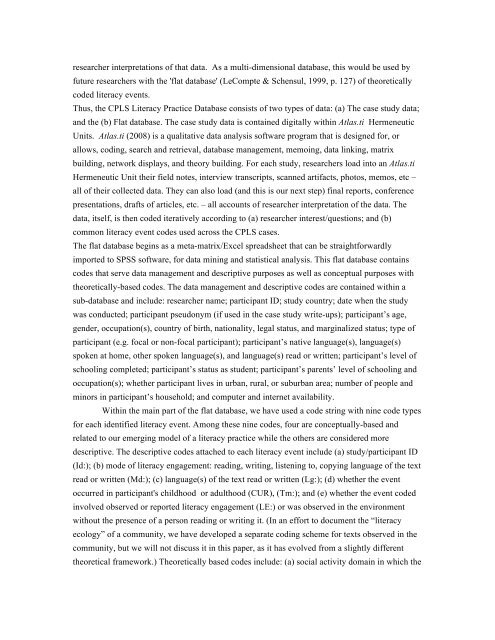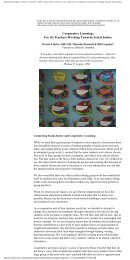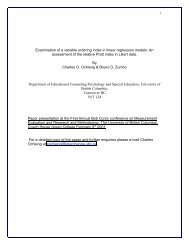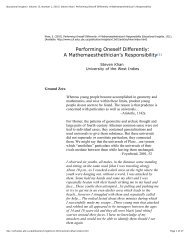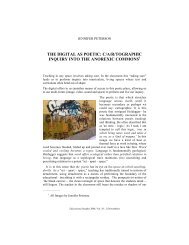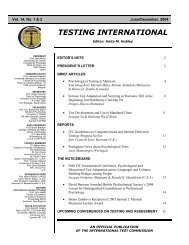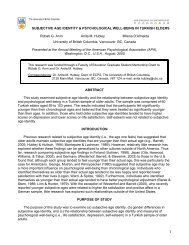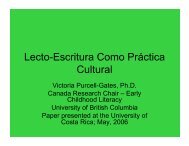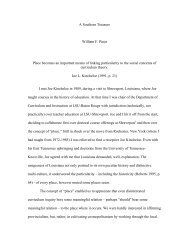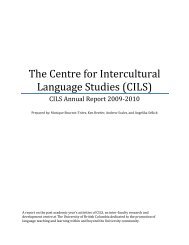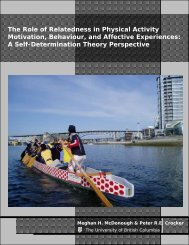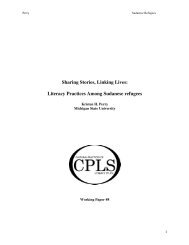Analyzing Literacy Practice - CPLS - University of British Columbia
Analyzing Literacy Practice - CPLS - University of British Columbia
Analyzing Literacy Practice - CPLS - University of British Columbia
Create successful ePaper yourself
Turn your PDF publications into a flip-book with our unique Google optimized e-Paper software.
esearcher interpretations <strong>of</strong> that data. As a multi-dimensional database, this would be used by<br />
future researchers with the 'flat database' (LeCompte & Schensul, 1999, p. 127) <strong>of</strong> theoretically<br />
coded literacy events.<br />
Thus, the <strong>CPLS</strong> <strong>Literacy</strong> <strong>Practice</strong> Database consists <strong>of</strong> two types <strong>of</strong> data: (a) The case study data;<br />
and the (b) Flat database. The case study data is contained digitally within Atlas.ti Hermeneutic<br />
Units. Atlas.ti (2008) is a qualitative data analysis s<strong>of</strong>tware program that is designed for, or<br />
allows, coding, search and retrieval, database management, memoing, data linking, matrix<br />
building, network displays, and theory building. For each study, researchers load into an Atlas.ti<br />
Hermeneutic Unit their field notes, interview transcripts, scanned artifacts, photos, memos, etc –<br />
all <strong>of</strong> their collected data. They can also load (and this is our next step) final reports, conference<br />
presentations, drafts <strong>of</strong> articles, etc. – all accounts <strong>of</strong> researcher interpretation <strong>of</strong> the data. The<br />
data, itself, is then coded iteratively according to (a) researcher interest/questions; and (b)<br />
common literacy event codes used across the <strong>CPLS</strong> cases.<br />
The flat database begins as a meta-matrix/Excel spreadsheet that can be straightforwardly<br />
imported to SPSS s<strong>of</strong>tware, for data mining and statistical analysis. This flat database contains<br />
codes that serve data management and descriptive purposes as well as conceptual purposes with<br />
theoretically-based codes. The data management and descriptive codes are contained within a<br />
sub-database and include: researcher name; participant ID; study country; date when the study<br />
was conducted; participant pseudonym (if used in the case study write-ups); participant’s age,<br />
gender, occupation(s), country <strong>of</strong> birth, nationality, legal status, and marginalized status; type <strong>of</strong><br />
participant (e.g. focal or non-focal participant); participant’s native language(s), language(s)<br />
spoken at home, other spoken language(s), and language(s) read or written; participant’s level <strong>of</strong><br />
schooling completed; participant’s status as student; participant’s parents’ level <strong>of</strong> schooling and<br />
occupation(s); whether participant lives in urban, rural, or suburban area; number <strong>of</strong> people and<br />
minors in participant’s household; and computer and internet availability.<br />
Within the main part <strong>of</strong> the flat database, we have used a code string with nine code types<br />
for each identified literacy event. Among these nine codes, four are conceptually-based and<br />
related to our emerging model <strong>of</strong> a literacy practice while the others are considered more<br />
descriptive. The descriptive codes attached to each literacy event include (a) study/participant ID<br />
(Id:); (b) mode <strong>of</strong> literacy engagement: reading, writing, listening to, copying language <strong>of</strong> the text<br />
read or written (Md:); (c) language(s) <strong>of</strong> the text read or written (Lg:); (d) whether the event<br />
occurred in participant's childhood or adulthood (CUR), (Tm:); and (e) whether the event coded<br />
involved observed or reported literacy engagement (LE:) or was observed in the environment<br />
without the presence <strong>of</strong> a person reading or writing it. (In an effort to document the “literacy<br />
ecology” <strong>of</strong> a community, we have developed a separate coding scheme for texts observed in the<br />
community, but we will not discuss it in this paper, as it has evolved from a slightly different<br />
theoretical framework.) Theoretically based codes include: (a) social activity domain in which the


